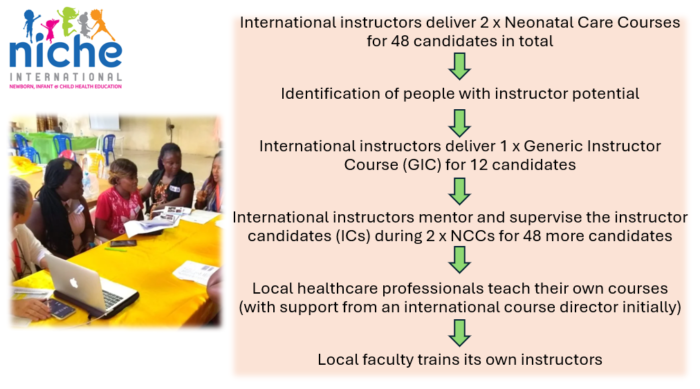On 31st July we ran our first Information Webinar for potential volunteers. We were delighted to see many keen people and some Cameroonian colleagues in attendance.
The best questions in the webinar were ‘How do we maintain the standards of the Instructors?” and ‘how do we know that what is taught on the course is incorporated into practice?”. Both of these issues remain a challenge, and are linked to the Holy Grail of skills retention.

Dr Jarlath O’Donohoe muses on this further:
NICHE has a well developed structure of training, based on educational approaches that are used in resource rich countries for clinical training. However it is clear that there is a significant loss of skill and knowledge in the few months following a training course, wherever in the world that course is delivered. To help trainers keep up to date and to develop, NICHE has recently begun facilitating Instructor Development days for established overseas faculty members.
In high income countries attempts to overcome the loss of skills by practitioners principally revolve around repeat attendance at the training course, usually at an interval of years (often 4 years). The 4 year gap is for financial reasons principally because the forgetting curve (see diagram above) is pretty much at the bottom of the graph by the time people redo their provider courses. For practical and educational reasons, it may be worth trying to identify other techniques that practitioners could use to retain skills.
Various modifications of training technique have been suggested to help with skill retention and programme scale-up. These include discussing things with an inanimate object (a rubber duck is the example given) which has been recommended in the world of computer learning. “Simply talking about it will lead to enlightenment” Thomas D and Hunt A wrote in The Pragmatic Programming. Pearson Education Inc. 20th Anniversary Edition.

For those not keen on talking to inanimate objects a closely related technique is the Feynman technique which has 4 stages. Imagine you are trying to teach something to an 10 year old child. Write down your description of what you are trying to learn. Identify the gaps and lastly find ways of filling in those gaps. This is Lernen durch Lehren, German for Learning by Teaching.
Mental imaging and rehearsal: athletes and surgeons often mentally rehearse their technique before implementing it. Instructors of life support courses practice exactly what they are going to demonstrate before teaching it. Results indicate that the more complex the teaching activity is, the more opportunities there are to learn by teaching. NICHE encourages the incorporation and extension of practices that provide opportunities for instructors to continue to learn by teaching their peers, peer tutoring and/or peer assessment (Duran, D. (2016). Learning-by-teaching. Evidence and implications as a pedagogical mechanism. Innovations in Education and Teaching International, 54(5), 476–484. https://doi.org/10.1080/14703297.2016.1156011). We have recently successfully fund raised for extra manikins to be sent to Cameroon faculty members for on-going microteaching sessions in instructors’ own healthcare facilities.
The forgetting curve and prevention of skills decay could be one of the discussion topics in the next Instructor Development Days.

